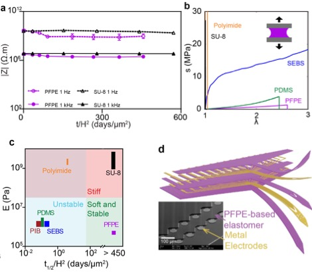Perfluorinated Elastomers for Bioelectronics

A team at the Harvard MRSEC led by Liu and Suo has developed perfluoropolyether-based elastomers that are soft, stable, and photolithographically patternable. These materials are being investigated for use in implantable electrodes for the brain-machine interface. Most elastomers experience degradation of their dielectric performance when immersed in biological fluids due to ion transport. However, measurements carried out in different elastomeric materials reveals that perfluoropolyether-based elastomers retain their dielectric properties due to their low ionic conductivity. The team then fabricated multilayer probes composed of this elastomer and metal electrodes that are capable of measuring brain activity at single-cell resolution. This research connects to NSF's Big Idea: Future of Work at the Human-Technology Frontier.
Publication:
P. Le Floch, S. Hao, Z. Suo, and J. Liu, "Perfluorinated elastomers for long-lived, soft and high-density brain-machine interface," (In preparation)
Jia Liu (BioE), and
Zhigang Suo (MechE)
2020-2021 Harvard MRSEC (DMR-2011754)
